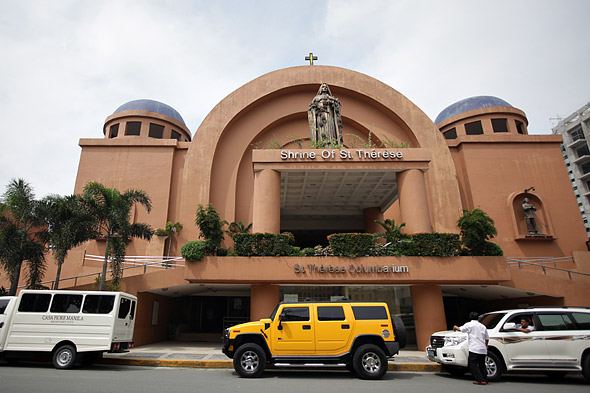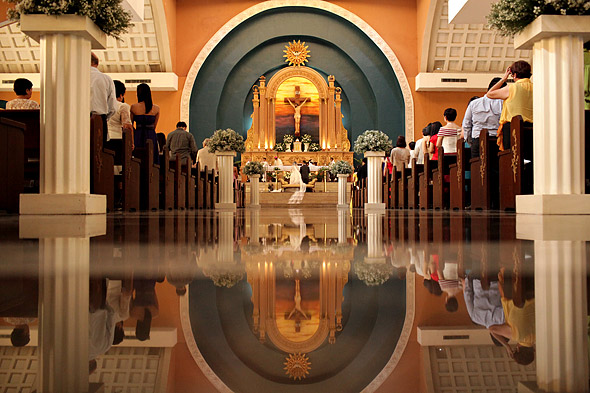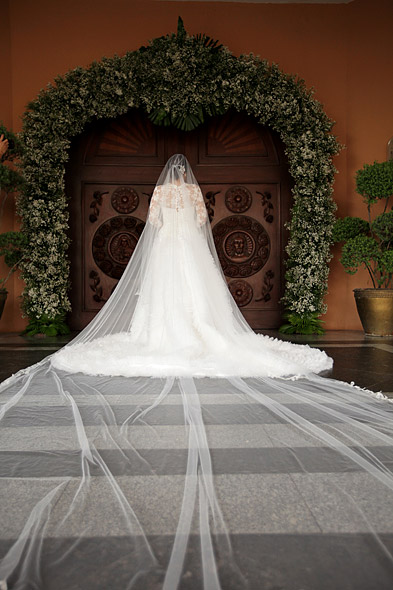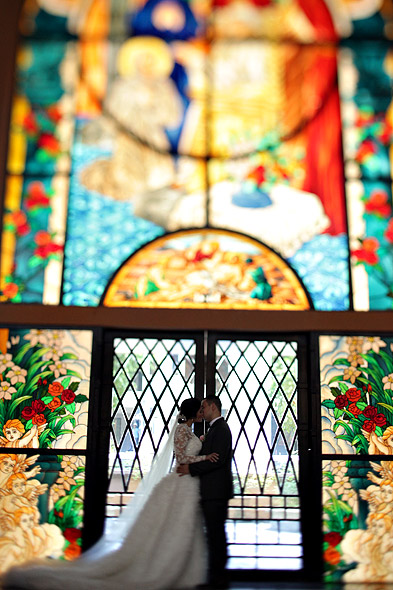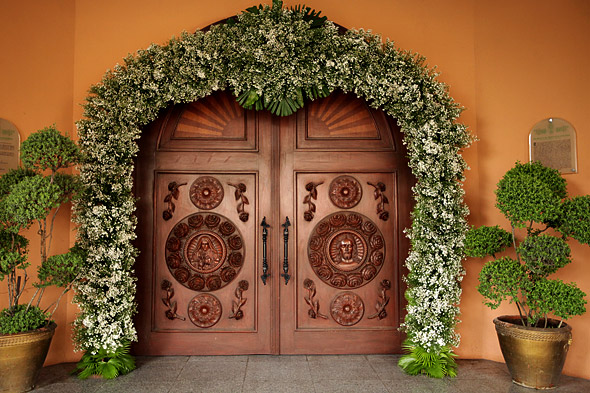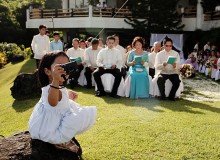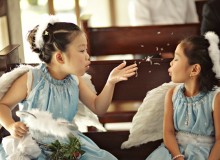Shrine of St. Therese and the Holy Face Pasay: Perfect for big classic weddings
The Shrine of St. Therese of the Child Jesus and the Holy Face inside the Villamor Air Base compound is actually one of Metro Manila’s newest churches. Its structure and architecture, described as “classic contemporary”, is reminiscent of the massiveness of the Basilica of St. Therese in Lisieux, Normandy, France’s second largest pilgrimage site next to Lourdes.
The shrine started out as a chapel originally dedicated to St. Michael the Archangel. The Philippine Air Force chaplains assigned to the air base expanded it several times because of the increasing number of personnel within the base. In December 1983, it underwent a major reconstruction and was dedicated by the then Apostolic Nuncio to the Philippines, Archbishop Bruno Torpigliani, to St. Therese of the Child Jesus. The church is also known as the Diocesan Shrine of the Military Ordinariate in the Philippines.
The church’s website says that the shrine is the “center of devotion to the Saint in Asia.” St. Therese was also known as St. Therese of Lisieux, but is now more known as St. Therese of the Child Jesus and of the Holy Face. She was a Carmelite nun who entered the religious life at 15 years old; died of tuberculosis when she was 24 years old; and was beatified as a saint 28 years later. She was declared the 33rd – the youngest and third woman – Doctor of the Church by Pope John Paul II for having influenced, through her writings and her life, the lives of so many including Padre Pio of Pietrelcina, Italy and Mother Teresa of Calcutta, India. She is also considered France’s co-patron, along with St. Joan of Arc.
Few know that the massive, adobe-colored structure fronting Terminal 3 of the Ninoy Aquino International Airport in Pasay City can be a venue for weddings. But the shrine is actually perfect for big weddings with its spacious, striking colors and features and its 50-meter long aisle. The three-level complex’s basement has 168 parking slots, with a driveway ramp leading from the ground to the church itself at the top level. (The ground level is actually where the columbary and adoration chapel are located.)
The two wooden panels of the church’s main entrance show two carved images, each encircled in 12, or a total of 24, roses – an allusion to St. Therese being the “Little Flower of Jesus” and her age, 24, when she died. One of the carved images is of the saint, and the other, of Jesus’ Holy Face, to which the saint had a special devotion. These doors open up to a huge, spacious, column-less interior, in rich earth or golden hues with touches of white. About 1,800 people can be seated in pews custom-designed with a cross, symbolizing the Church, and three roses, symbolizing the saint’s three books.
The altar is elevated a few steps up in front. Twenty-four roses are carved intricately around it, again signifying the saint’s age, and dramatically set beneath a royal blue arch. Locally-made altar pieces are of gold-leaf finish, with the crucifix at the center and set against a background of colors reminiscent of the sunset. High above is the church’s domed roof, with a diameter of 60 feet and highlighted with 16 stained glass images. These depict seven saints and nine popes that were connected to St. Therese’s life and sainthood.
Meanwhile, the window panels along the sides of the church are in stained glass each beautifully designed to depict two types of images: important aspects of St. Therese’s life in the upper portion; and, within a semi-circle at the bottom portion, the stations of the [old] Way of the Cross. Other images that can be seen in different areas inside the church include The Lady of All Nations, Our Lady of Victories, Our Lady of the Smile, and Jesus King of Mercy.
At the back of the church, above the entrance, is the enclosed Our Lady of the Smile multi-purpose hall set off by glass to allow people inside it to still witness what is happening within the church – perfect to hold crying kids and prevent them from disturbing other churchgoers. There is also a balcony that provides photographers a perfect view of the altar.
The Shrine allows weddings to take place at 10:00 AM and 3:00 PM from Tuesdays to Saturdays, and 2:00 PM on Sundays. Reservations require a 50% downpayment, at least three months before the actual wedding date. The hefty P40,000 fee covers the use of air conditioners for one and a half hours; a basic package for flowers (although they have accredited florists); basic sound system; services of a priest, commentator, soloist and pianist; and – instead of the usual red carpet – a royal blue carpet similar to the altar background. A “lighter” package costs P27,000 for the services of the priest, florist, soloist, pianist and commentator; basic sound system; and the royal blue carpet.
The documentary requirements are the usual: wedding banns; baptismal and confirmation certificates; canonical interview; pre-Cana seminar; list of sponsors; and marriage license. The list of liturgical and sacred music must be submitted to the Shrine Vicar for Liturgy, for his approval, at least a month before the wedding date. As for the entourage, child members such as the ring and coin bearers and flower girls should be no less than 5 years old. The parish priest or his representative may also check the attire of the bride and the rest of the entourage for appropriateness.
The air-conditioned multipurpose hall may serve as a reception venue, but other venues abound in the area, especially in the nearby Resorts World or as far as Taguig, Makati or Parañaque cities.



